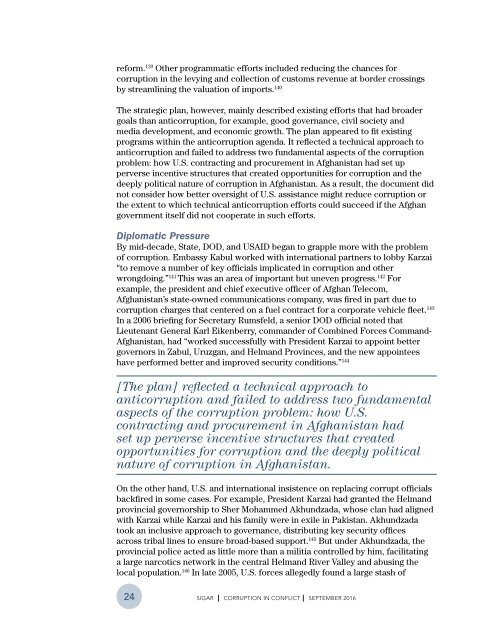CORRUPTION IN CONFLICT
5IlaWjQej
5IlaWjQej
Create successful ePaper yourself
Turn your PDF publications into a flip-book with our unique Google optimized e-Paper software.
eform. 139 Other programmatic efforts included reducing the chances for<br />
corruption in the levying and collection of customs revenue at border crossings<br />
by streamlining the valuation of imports. 140<br />
The strategic plan, however, mainly described existing efforts that had broader<br />
goals than anticorruption, for example, good governance, civil society and<br />
media development, and economic growth. The plan appeared to fit existing<br />
programs within the anticorruption agenda. It reflected a technical approach to<br />
anticorruption and failed to address two fundamental aspects of the corruption<br />
problem: how U.S. contracting and procurement in Afghanistan had set up<br />
perverse incentive structures that created opportunities for corruption and the<br />
deeply political nature of corruption in Afghanistan. As a result, the document did<br />
not consider how better oversight of U.S. assistance might reduce corruption or<br />
the extent to which technical anticorruption efforts could succeed if the Afghan<br />
government itself did not cooperate in such efforts.<br />
Diplomatic Pressure<br />
By mid-decade, State, DOD, and USAID began to grapple more with the problem<br />
of corruption. Embassy Kabul worked with international partners to lobby Karzai<br />
“to remove a number of key officials implicated in corruption and other<br />
wrongdoing.” 141 This was an area of important but uneven progress. 142 For<br />
example, the president and chief executive officer of Afghan Telecom,<br />
Afghanistan’s state-owned communications company, was fired in part due to<br />
corruption charges that centered on a fuel contract for a corporate vehicle fleet. 143<br />
In a 2006 briefing for Secretary Rumsfeld, a senior DOD official noted that<br />
Lieutenant General Karl Eikenberry, commander of Combined Forces Command-<br />
Afghanistan, had “worked successfully with President Karzai to appoint better<br />
governors in Zabul, Uruzgan, and Helmand Provinces, and the new appointees<br />
have performed better and improved security conditions.” 144<br />
[The plan] reflected a technical approach to<br />
anticorruption and failed to address two fundamental<br />
aspects of the corruption problem: how U.S.<br />
contracting and procurement in Afghanistan had<br />
set up perverse incentive structures that created<br />
opportunities for corruption and the deeply political<br />
nature of corruption in Afghanistan.<br />
On the other hand, U.S. and international insistence on replacing corrupt officials<br />
backfired in some cases. For example, President Karzai had granted the Helmand<br />
provincial governorship to Sher Mohammed Akhundzada, whose clan had aligned<br />
with Karzai while Karzai and his family were in exile in Pakistan. Akhundzada<br />
took an inclusive approach to governance, distributing key security offices<br />
across tribal lines to ensure broad-based support. 145 But under Akhundzada, the<br />
provincial police acted as little more than a militia controlled by him, facilitating<br />
a large narcotics network in the central Helmand River Valley and abusing the<br />
local population. 146 In late 2005, U.S. forces allegedly found a large stash of<br />
24<br />
SIGAR I <strong>CORRUPTION</strong> <strong>IN</strong> <strong>CONFLICT</strong> I SEPTEMBER 2016


